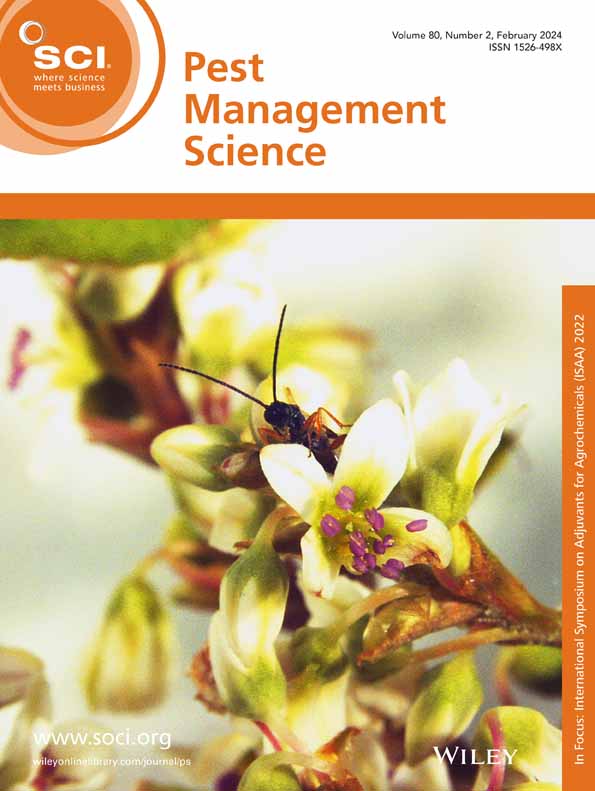Identifying key parameters for reliable assessment of entomopathogenic nematodes viability as affected by spray application stress‐related factors
IF 3.8
1区 农林科学
Q1 AGRONOMY
Roberto Beltrán‐Martí, Marco Resecco, Elena Gonella, Sofía Victoria Prieto, Marco Pittarello, Cruz Garcerá, Patricia Chueca, Alberto Alma, Fabrizio Gioelli, Marco Grella
求助PDF
{"title":"Identifying key parameters for reliable assessment of entomopathogenic nematodes viability as affected by spray application stress‐related factors","authors":"Roberto Beltrán‐Martí, Marco Resecco, Elena Gonella, Sofía Victoria Prieto, Marco Pittarello, Cruz Garcerá, Patricia Chueca, Alberto Alma, Fabrizio Gioelli, Marco Grella","doi":"10.1002/ps.8847","DOIUrl":null,"url":null,"abstract":"BACKGROUNDConventional pesticide application equipment (PAE) is used to apply entomopathogenic nematode (EPN)‐based bioinsecticides, but their closed hydraulic systems could raise the temperature of the spray mixture up to 40 °C, potentially harming EPN, since temperatures above 30 °C can immobilize nematodes, reducing their infective capacity. This study aimed to identify the most suitable method to evaluate EPN viability under the effects of PAE technology.RESULTSThree EPN species—<jats:italic>Heterorhabditis bacteriophora, Steinernema feltiae,</jats:italic> and <jats:italic>Steinernema carpocapsae</jats:italic>—were exposed to thermal stress (10, 20, 30, and 40 °C for 270 min) to simulate spray application conditions. Three viability evaluation methods were compared: prodding stimulation, NaCl chemical stimulation, and no stimulation. Viability was measured by two parameters depending on the assessment method: % actively EPN moving (activity), or % total live EPN, both actively moving and immobile (survival). Additionally, a novel parameter estimating non‐lethal stress (Δ<jats:sub>nl s</jats:sub>) was defined by measuring the live but inactive EPNs. NaCl stimulation was optimized comparing different concentrations and durations and then set at 0.1 g mL<jats:sup>−1</jats:sup> for 1 min. Temperature significantly affected EPN viability over time. Temperatures around 20 °C preserved optimal conditions, and above 30 °C negatively affected EPN viability, with mortality close to 80% within 90 min at 40 °C. Prodding (measuring survival) yielded higher viability compared to NaCl and no stimulation, which measured activity. Non‐lethal stress parameter increased accordingly to stress increment showing potential as EPN stress‐marker.CONCLUSIONThe study concluded that combined measurement of survival, activity and non‐lethal stress should be considered in EPN viability assessments when designing PAE to ensure high efficacy of biocontrol agents. © 2025 The Author(s). <jats:italic>Pest Management Science</jats:italic> published by John Wiley & Sons Ltd on behalf of Society of Chemical Industry.","PeriodicalId":218,"journal":{"name":"Pest Management Science","volume":"9 1","pages":""},"PeriodicalIF":3.8000,"publicationDate":"2025-04-26","publicationTypes":"Journal Article","fieldsOfStudy":null,"isOpenAccess":false,"openAccessPdf":"","citationCount":"0","resultStr":null,"platform":"Semanticscholar","paperid":null,"PeriodicalName":"Pest Management Science","FirstCategoryId":"97","ListUrlMain":"https://doi.org/10.1002/ps.8847","RegionNum":1,"RegionCategory":"农林科学","ArticlePicture":[],"TitleCN":null,"AbstractTextCN":null,"PMCID":null,"EPubDate":"","PubModel":"","JCR":"Q1","JCRName":"AGRONOMY","Score":null,"Total":0}
引用次数: 0
引用
批量引用
Abstract
BACKGROUNDConventional pesticide application equipment (PAE) is used to apply entomopathogenic nematode (EPN)‐based bioinsecticides, but their closed hydraulic systems could raise the temperature of the spray mixture up to 40 °C, potentially harming EPN, since temperatures above 30 °C can immobilize nematodes, reducing their infective capacity. This study aimed to identify the most suitable method to evaluate EPN viability under the effects of PAE technology.RESULTSThree EPN species—Heterorhabditis bacteriophora, Steinernema feltiae, and Steinernema carpocapsae —were exposed to thermal stress (10, 20, 30, and 40 °C for 270 min) to simulate spray application conditions. Three viability evaluation methods were compared: prodding stimulation, NaCl chemical stimulation, and no stimulation. Viability was measured by two parameters depending on the assessment method: % actively EPN moving (activity), or % total live EPN, both actively moving and immobile (survival). Additionally, a novel parameter estimating non‐lethal stress (Δnl s ) was defined by measuring the live but inactive EPNs. NaCl stimulation was optimized comparing different concentrations and durations and then set at 0.1 g mL−1 for 1 min. Temperature significantly affected EPN viability over time. Temperatures around 20 °C preserved optimal conditions, and above 30 °C negatively affected EPN viability, with mortality close to 80% within 90 min at 40 °C. Prodding (measuring survival) yielded higher viability compared to NaCl and no stimulation, which measured activity. Non‐lethal stress parameter increased accordingly to stress increment showing potential as EPN stress‐marker.CONCLUSIONThe study concluded that combined measurement of survival, activity and non‐lethal stress should be considered in EPN viability assessments when designing PAE to ensure high efficacy of biocontrol agents. © 2025 The Author(s). Pest Management Science published by John Wiley & Sons Ltd on behalf of Society of Chemical Industry.
确定可靠评估昆虫病原线虫活力的关键参数,以确定受喷施胁迫相关因素的影响
传统的农药施用设备(PAE)用于施用基于昆虫病原线虫(EPN)的生物杀虫剂,但其封闭的液压系统可能会将喷雾混合物的温度提高到40°C,这可能对EPN有害,因为温度超过30°C会使线虫无法活动,降低其感染能力。本研究旨在确定PAE技术作用下EPN活力评价的最合适方法。结果将3种EPN——嗜菌异芽孢杆菌(heterorhabditis bacteriophora)、feltiae芽孢杆菌(steinerma feltiae)和carpocapae芽孢杆菌(steinerma carpocapae)——暴露在10、20、30和40°C的热应激条件下270 min,以模拟喷雾条件。比较了三种生存力评价方法:刺激增产、NaCl化学增产和不增产。根据评估方法,通过两个参数来衡量生存能力:主动移动的EPN(活性)百分比,或总活EPN %,包括主动移动和不移动(存活)。此外,通过测量存活但不活跃的epn,定义了一个估算非致死应力的新参数(Δnl s)。通过比较不同浓度和持续时间的NaCl刺激进行优化,然后在0.1 g mL−1条件下刺激1分钟。随着时间的推移,温度显著影响EPN的活力。温度在20°C左右可保持最佳条件,而温度在30°C以上会对EPN的活力产生负面影响,在40°C条件下,90分钟内死亡率接近80%。刺激(测量存活)比NaCl和不刺激(测量活性)产生更高的活力。非致死应力参数随应力的增加而增加,显示出作为EPN应力标记物的潜力。结论在设计PAE时,应综合考虑EPN存活、活性和非致死应激的测定,以确保生物防治药剂的高效使用。©2025作者。《病虫害管理科学》由John Wiley &出版;我代表化学工业协会的儿子有限公司。
本文章由计算机程序翻译,如有差异,请以英文原文为准。

 求助内容:
求助内容: 应助结果提醒方式:
应助结果提醒方式:


